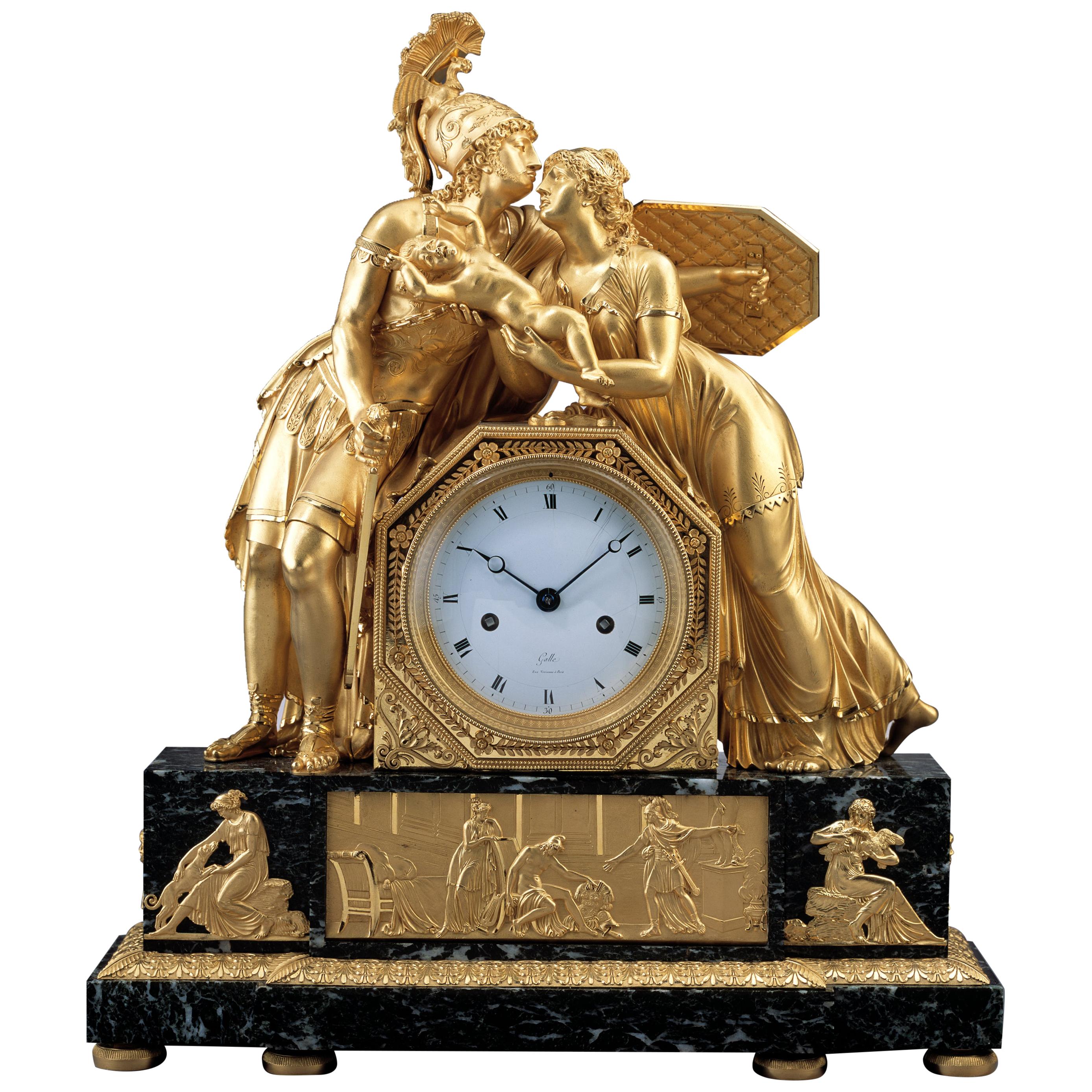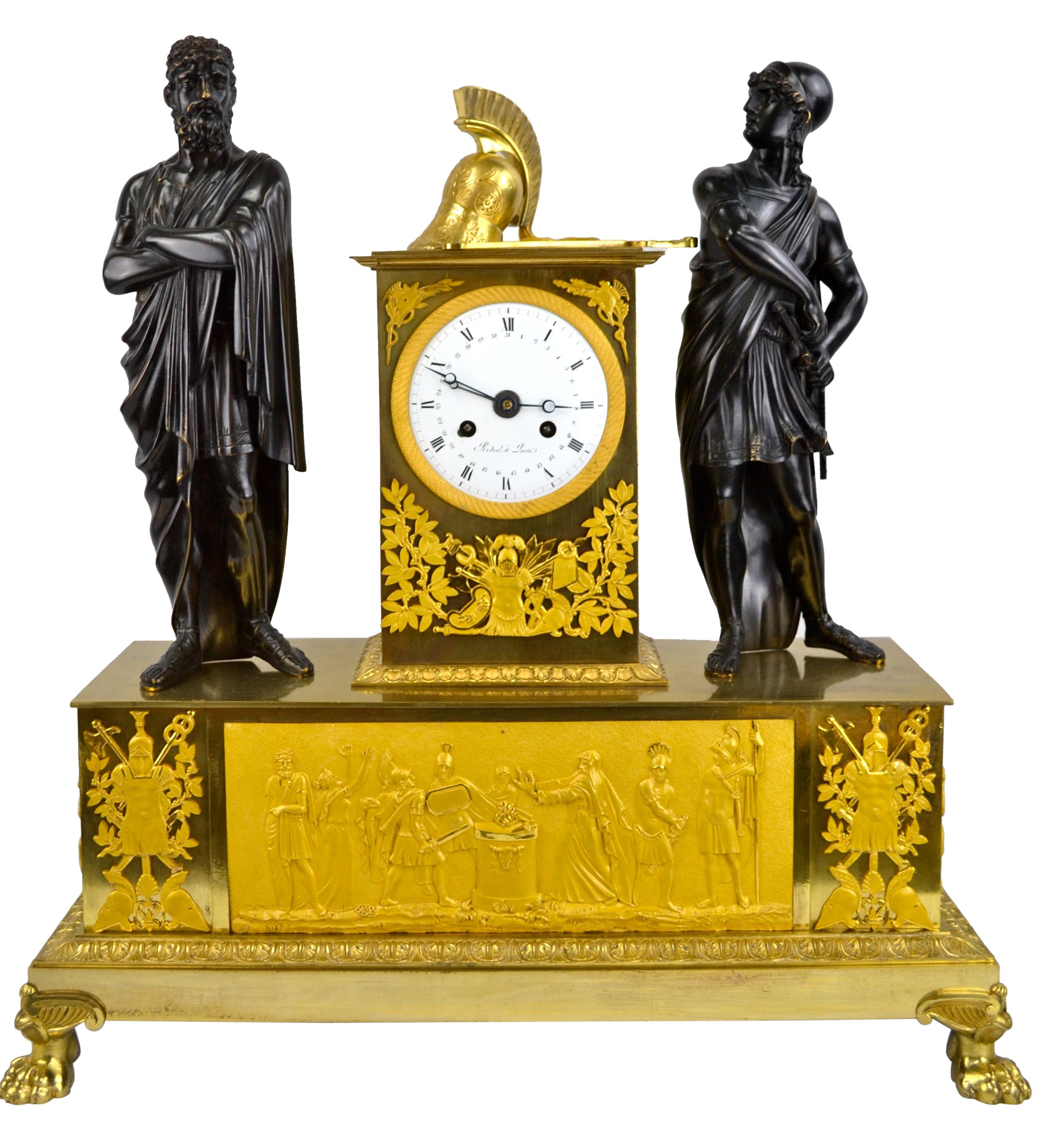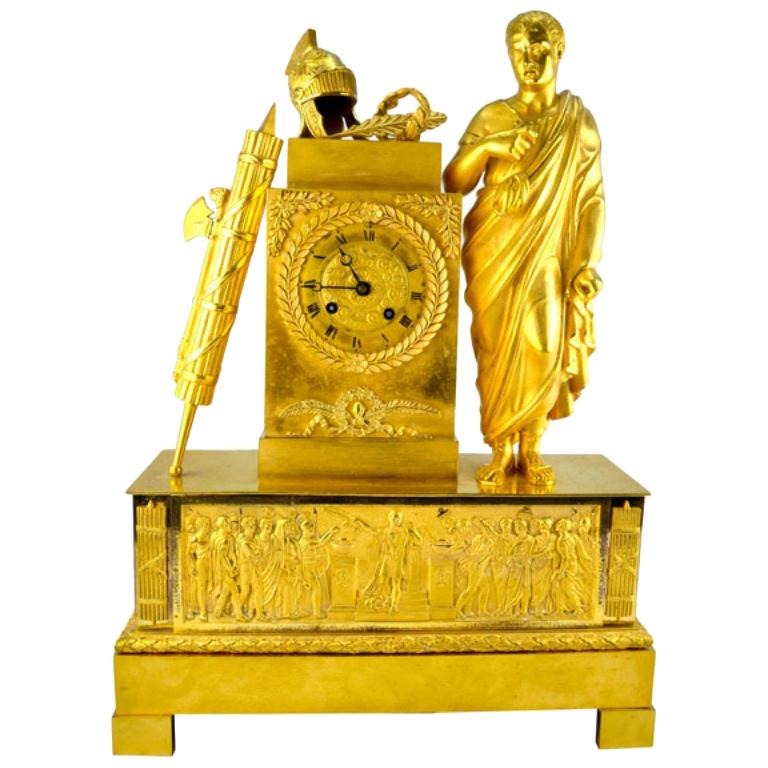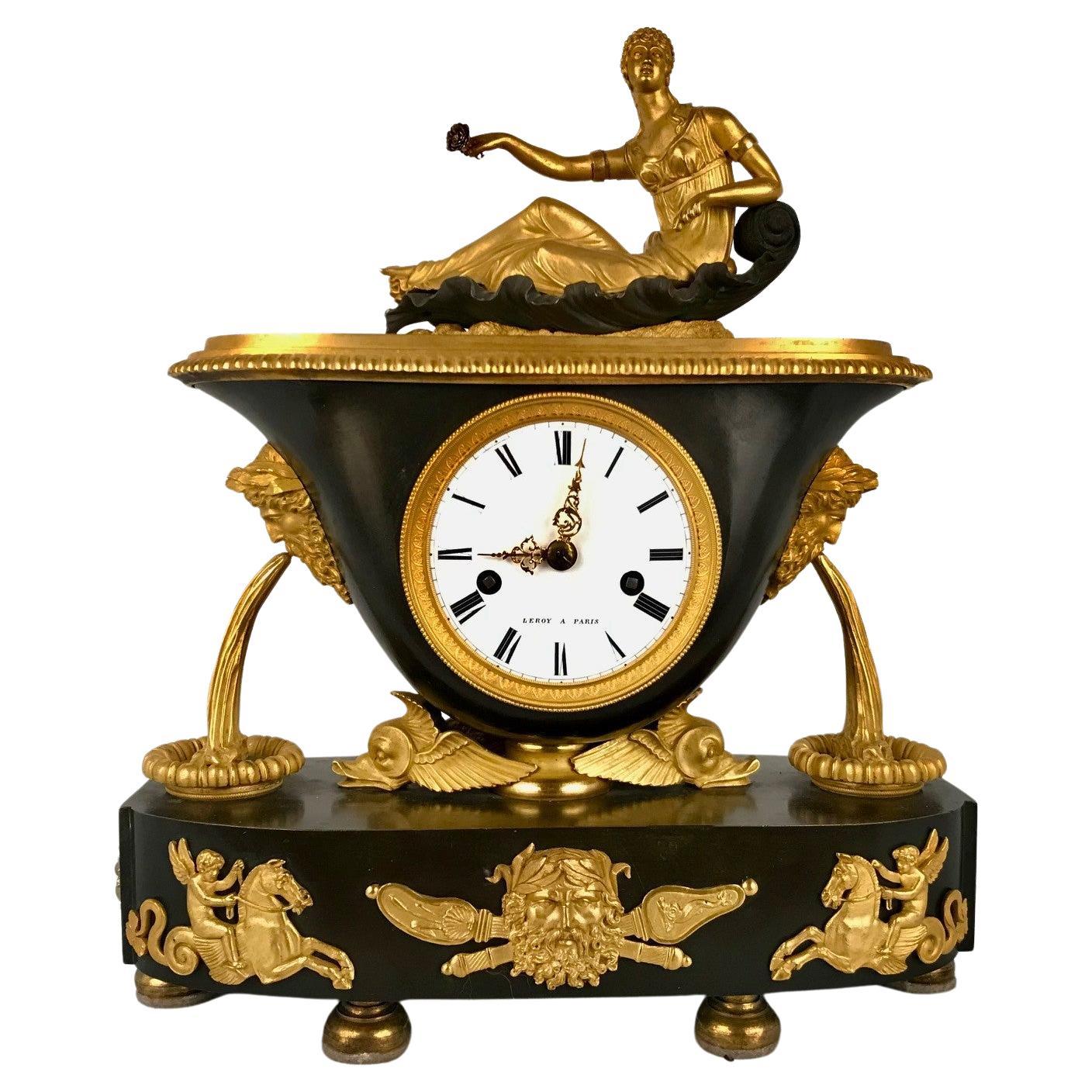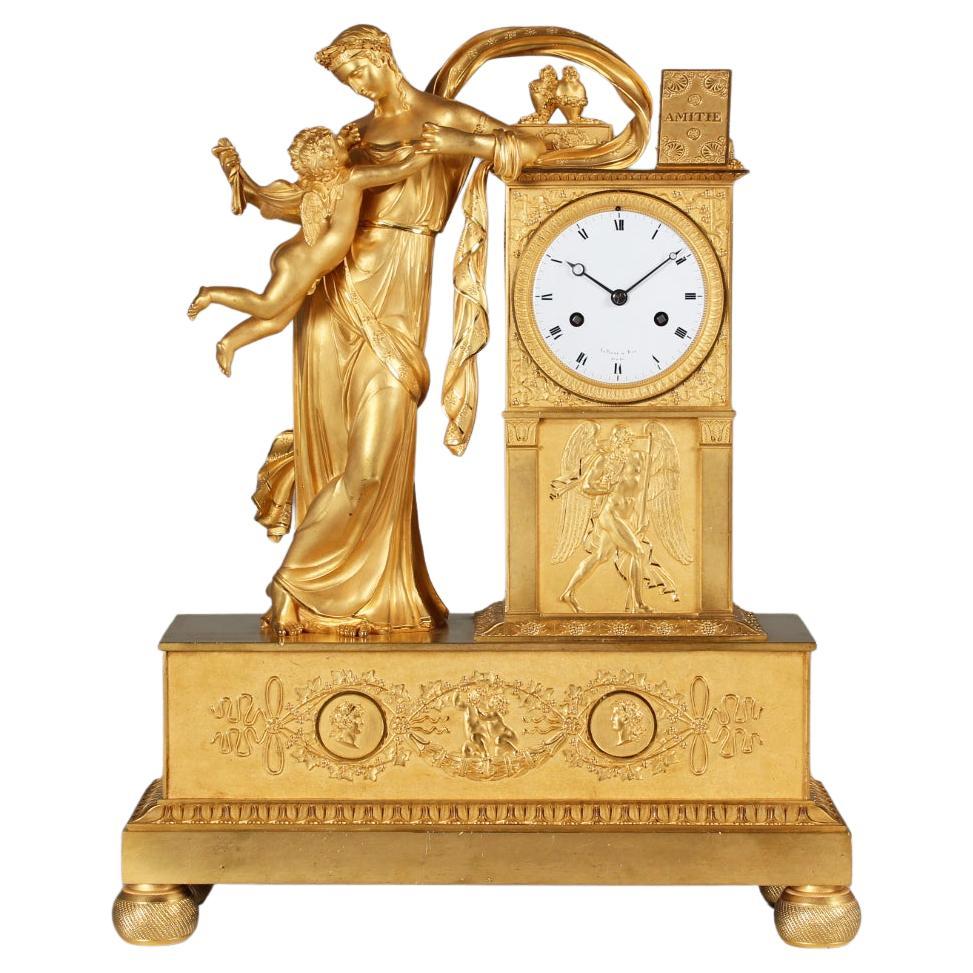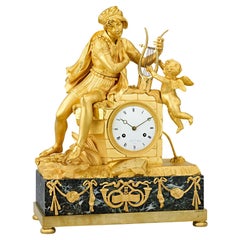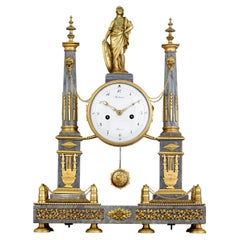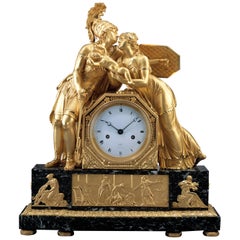Items Similar to Odysseus and Theseus French Empire Mantle Clock by André Antoine Ravrio
Want more images or videos?
Request additional images or videos from the seller
1 of 9
Odysseus and Theseus French Empire Mantle Clock by André Antoine Ravrio
$54,500
£41,294.09
€47,381.69
CA$76,690.30
A$84,303.74
CHF 44,306.18
MX$1,023,754.39
NOK 552,708.41
SEK 523,652.35
DKK 353,621.55
About the Item
Odysseus and Theseus French Empire Mantel Clock
André Antoine Ravrio
Circa 1800
This monumental Empire mantel clock by André Antoine Ravrio, whose case is crafted entirely of gilded bronze, is quite exceptional. It is one of only four known examples. Of the other three, one is held in a private collection, another resides in the Mobilier National in Paris, and the third belongs to the museum collection of the Prince de la Moskowa.
Commissioned during Napoleon's reign, the case was crafted by the emperor's personal bronzier, André Antoine Ravrio, and the mechanism by the Emperor’s clockmaker, Bazile-Charles Le Roy. The clock seamlessly marries the grandeur of Napoleon's modern empire with the timeless glory of Ancient Greece. The case itself is a work of art, as Ravrio masterfully presents ancient Greece’s most iconic heroes. On the left, the revered poet Homer is depicted in the act of composing his epic, The Odyssey, while his protagonist, Odysseus, stands triumphant to the right, reunited with his devoted wife, Penelope. Odysseus, freshly returned from his long journey filled with trials and dangers, holds his sword in hand, symbolizing his heroic victory and the fall of Troy.
The couple’s touching reunion takes place atop a pedestal adorned with a bronze frieze portraying Theseus’ legendary battle with the Minotaur. In this famous myth, Theseus bravely enters the labyrinth of King Minos to slay the Minotaur, a fearsome creature that demands human sacrifices, ultimately liberating Athens from its cruel tribute. Together, these stories capture the timeless themes of heroism, loyalty and the enduring legacy of ancient Greece.
Every element of this clock is a work of art, the result of a collaboration between the finest bronzier and clockmaker of the period. The enameled clock dial, signed "Le Roy br. de Madame/A Paris," features Roman numeral hour markers and minute graduations. Bazile-Charles Le Roy, founder of the prestigious Le Roy company in 1785 at the Palais Royal, relocated to Rue de la Egalité after 1789, later becoming the official clockmaker to Napoleon's mother.
André Antoine Ravrio (1759–1814), renowned for his lamps, girandoles, clocks and bronze mounts, was awarded a Silver Medal at the 1806 Exposition de l'Industrie in Paris. By 1810, he had been appointed bronzier to Napoleon, working at several imperial residences, including Saint-Cloud, Compiègne and the Tuileries. At the height of his career, Ravrio's workshop employed as many as 100 artisans, producing designs coveted for their ingenious integration of form and exceptional quality, and this clock is the very finest example known on the market.
25" high x 23 1/8" wide x 9" deep
Provenance:
Mrs. E.P. Corbin, from 1949 in New York
Private collection, Bath, England
M.S. Rau, New Orleans
- Dimensions:Height: 25 in (63.5 cm)Width: 23.13 in (58.76 cm)Depth: 9 in (22.86 cm)
- Style:Empire (Of the Period)
- Materials and Techniques:
- Place of Origin:
- Period:
- Date of Manufacture:Circa 1800
- Condition:
- Seller Location:New Orleans, LA
- Reference Number:Seller: 31-86591stDibs: LU891141640792
About the Seller
5.0
Recognized Seller
These prestigious sellers are industry leaders and represent the highest echelon for item quality and design.
Established in 1912
1stDibs seller since 2010
112 sales on 1stDibs
Typical response time: 8 hours
- ShippingRetrieving quote...Shipping from: New Orleans, LA
- Return Policy
Authenticity Guarantee
In the unlikely event there’s an issue with an item’s authenticity, contact us within 1 year for a full refund. DetailsMoney-Back Guarantee
If your item is not as described, is damaged in transit, or does not arrive, contact us within 7 days for a full refund. Details24-Hour Cancellation
You have a 24-hour grace period in which to reconsider your purchase, with no questions asked.Vetted Professional Sellers
Our world-class sellers must adhere to strict standards for service and quality, maintaining the integrity of our listings.Price-Match Guarantee
If you find that a seller listed the same item for a lower price elsewhere, we’ll match it.Trusted Global Delivery
Our best-in-class carrier network provides specialized shipping options worldwide, including custom delivery.More From This Seller
View AllFrench Empire Troubadour Mantel Clock
By Le Roy
Located in New Orleans, LA
This resplendent French Empire gilt bronze mantel clock features an extraordinarily detailed scene of a singing troubadour with his lyre along a rocky river bank. Accompanied by a wi...
Category
Antique 19th Century French Empire Mantel Clocks
Materials
Marble, Bronze
The Astronomy Lesson French Empire Mantel Clock
Located in New Orleans, LA
This magnificent French Empire ormolu mantel clock features the iconic Neoclassical genre scene often referred to as "The Astronomy Lesson." A popular motif during this period, Emper...
Category
Antique 19th Century French Empire Mantel Clocks
Materials
Marble, Enamel, Ormolu
Louis XVI Marble Mantle Clock by Jean-Nicolas Schmit
Located in New Orleans, LA
A horologic masterpiece of precision and beauty, this neoclassical marble and ormolu mantle clock is an extraordinary example of late 18th-century French clockmaking by the famed Jea...
Category
Antique 18th Century French Neoclassical Mantel Clocks
Materials
Marble, Ormolu
Monumental Three-Train Bracket Clock by J.C. Jennens & Sons
Located in New Orleans, LA
This intricately detailed 19th-century bracket clock from famed English firm J.C. Jennens & Sons is monumental in size, likely made for one of the great world exhibitions or perhaps to put in the firm's own store window. The eight-day timepiece has a triple fusee...
Category
Antique 19th Century English Table Clocks and Desk Clocks
Materials
Bronze
Vincenti et Cie Mantel Clock for Bailey, Banks & Biddle
Located in New Orleans, LA
Wooden Mantel Clock
Vincenti et Cie
Late 19th century
The mechanism is marked "Vincenti et Cie, Médaille d'Argent 1855, Made in France." Vincenti et Cie, established in 1823 by Jean Vincenti in Montbéliard, was revitalized by Albert Roux in 1829, who expanded and innovated the company. Under Roux's leadership, the firm continued its Montbéliard operations and opened a store in Paris in 1850 on Rue d'Anjou in the Marais. The company earned a silver medal (Médaille d'Argent) at the 1855 Exposition Universelle, for which this clock bears the mark "Médaille d'Argent, 1855," symbolizing its excellent craftsmanship.
The clock dial is marked Bailey, Banks & Biddle for the oldest nationwide jeweler in America, originally founded in 1832 in Philadelphia, Pennsylvania. The company is one of America's most prestigious retailers, known for creating the updated and final version of the Great Seal of the United States as well as the first 40,000 Purple Heart medals...
Category
Antique 19th Century French Mantel Clocks
Materials
Oak
Venus Clipping the Wings of Cupid Mantel Clock by Thomire & Cie
By Louis Moinet, Thomire & Cie.
Located in New Orleans, LA
This splendid Empire gilt bronze French mantel clock, signed on the dial by bronzier Pierre-Philippe Thomire and watchmaker Louis Moinet, features an exquisitely detailed scene of Ve...
Category
Antique 19th Century French Empire Mantel Clocks
Materials
Marble, Bronze
You May Also Like
French Early 19th Century Empire Gilt Bronze Mantel Clock by Claude Galle
By Claude Galle
Located in Worpswede / Bremen, DE
Claude Galle, (1759–1815, master in 1786) is one of the most renowned bronziers active during the Napoleonic period, such as Pierre-Philippe Thomire, André-Antoine Ravrio and Louis-S...
Category
Antique Early 1800s French Empire Mantel Clocks
Materials
Marble, Bronze
Early 19th Century Empire Mantel Clock by Ledure with Apollo or Eros
By Claude Hemon, Pierre-Victor Ledure
Located in Worpswede / Bremen, DE
The clock is signed on the enamel dial by the famous Parisian bronzier ”Ledure Bronzier à Paris” and the clockmaker ”Hedon Hr" (horloger). Patinated and fully sculpted bronze figure ...
Category
Antique Early 19th Century French Empire Mantel Clocks
Materials
Bronze
Allegorical French Empire clock Titled " Le Sacrifice d’Iphigénie "
By Claude Galle, Claude Galle
Located in Vancouver, British Columbia
A fine example of a period French Empire mantle clock which depicts the argument between Achilles and Agamemnon in Homer’s Iliad. The case is of matte and burnished gilded bronze, th...
Category
Antique Early 19th Century French Empire Mantel Clocks
Materials
Bronze
French Empire Allegorical Clock Depicting Roman Triumph and Power
Located in Vancouver, British Columbia
A figural gilt bronze French Empire clock, ‘Allegory to Triumph and Power’. A Roman emperor stands to the right of the central rectangular plinth housing the movement; atop the plint...
Category
Antique Early 19th Century French Empire Mantel Clocks
Materials
Bronze
Empire Period Mantle Clock by Leroy a Paris
Located in Montreal, QC
This mantle clock is by a well-respected Paris maker in a fashionable style. The oval base supports a vase shaped clock case in turn supported by winged dolphin heads and flanked by ...
Category
Antique 1810s French Empire Mantel Clocks
Materials
Bronze, Ormolu
French Empire Ormulu Bronze Mantel Clock, Lepaute, Thomire, Paris, circa 1815
Located in Greven, DE
Ormulu pendule with depiction of friendship and love
Paris (Lepaute, Thomire)
fire-gilt bronze
Empire around 1815
Dimensions: H x W x D: 44 x 36 x 13 cm
French pendulum movement with eight days duration. Thread suspension and lock disc striking movement with strike on bell on the half and full hour.
White enamel dial with Roman hour numerals and Breguet hands.
Signature: LePaute & Fils / Hrl. du Roi (Pierre-Basile Lepaute (1750 - 1843) with his son Pierre-Michel Lepaute (1785-1849); from 1811 in joint workshop).
Description:
The extremely high quality pendulum shown here takes up a profound theme: Friendship, which combines with love and can thereby outlast time and death. As it is typical for the epoch of classicism, personifications and symbols are taken from the fund of ancient mythology and art and then developed further.
The main figure is a young woman in an antique, girded garment, standing barefoot and with crossed legs next to an altar, on which she is leaning with her left elbow. She gracefully bows her head towards a tempestuously approaching Cupid, grasps his right hand with her left and draws him to her bosom, the seat of the heart. The delicate ambivalence of flying towards and being held culminates in the trustingly intimate look that the two cast at each other.
The young woman personifies friendship, the winged Cupid love. As a sign of their intimate connection, two burning hearts appear on the altar next to the two, framed by the puffed scarf, which are closely bound together by a chain of flowers.
Next to them, on the altar slab, one can see an erected book with the title "Amitie" (French: amitie, friendship). Supporting the book is a pomegranate held by a ring of pomegranate flowers. The bursting seeds spill out of the cracked skin. Since ancient times, the pomegranate and its blossoms have been dedicated to the goddess Persephone, symbolizing the underworld and death, but also life and fertility. The myrtle interwoven in the pomegranate flower wreath of "friendship" also has a far-reaching symbolic power: the plant was dedicated to the goddess Aphrodite, stands for virginity, and was and is therefore obligatory in the bridal wreath...
Category
Antique Early 19th Century French Empire Mantel Clocks
Materials
Bronze, Enamel
More Ways To Browse
Bronze Frieze
Girandole Lamps
Theseus Minotaur
Antique Greek Icons
Le Roy Paris
Bronze Ravrio
Ravrio Bronze Clock
Girandole Clock
French Mahogany Clock
Gold Rococo Clock
Mahogany Bracket Clock
Sevre Panels
Victorian Brass And Marble
Clock Finials
Clock Parts
Red Antique Clock
18th Century Clock Marble
Napoleon Marble Clock
